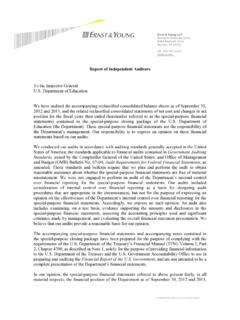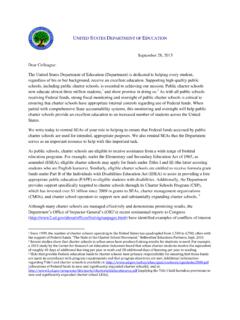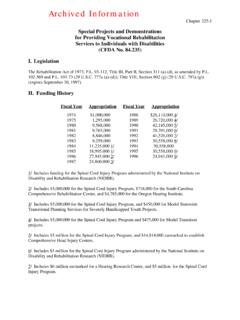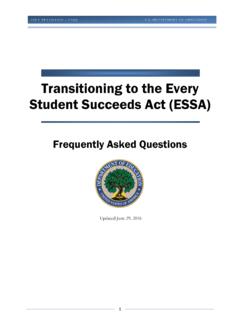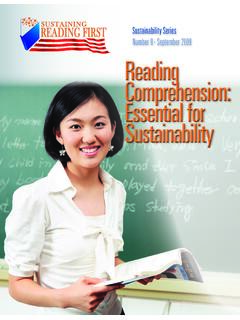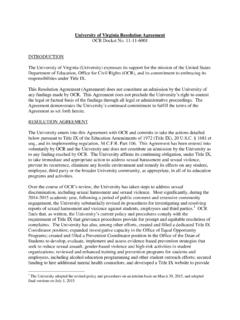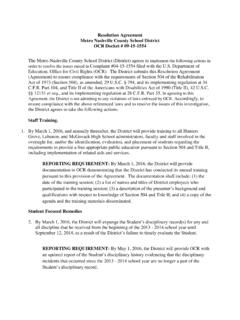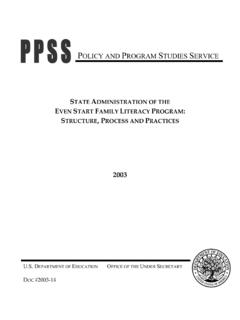Transcription of Archived: The Educational System in the United States ...
1 Archived Information The Educational System in the United States : Case Study Findings National Institute on Student Achievement, Curriculum, and Assessment Office of Educational Research and Improvement Department of Education Acknowledgments The Case Study Project was directed by Harold Stevenson and co-directed by Shin- Ying Lee of the University of Michigan's Center for Human Growth and Develop- ment. From careful conceptual planning to the insightful feedback on multiple drafts of these chapters, their leadership has been inspirational and motivating. The project was administered by Roberta Nerison-Low, whose attention to the day-to-day management of a project unfolding on three continents made the entire endeavor possible. We would like to thank Lois Peak of the National Center for Education Statistics at the Department of Education, who coordinated the Case Study Project with the other major studies in this collaborative effort. We would like to thank those at Westat, Inc.
2 , especially Trevor Williams and nancy Caldwell, who provided administrative and organizational support. Our appreciation also goes to the mem- bers of the advisory panel who provided useful comments on the chapter drafts, including Robert LeVine and others. We also thank David Uttal and Kathleen Dar- ling for providing us with knowledgeable assistance in the planning stages of the project. In addition, we would like to acknowledge and thank the individuals who researched and wrote the literature review of the topics slated to be investigated in the case studies in Japan, Germany and the United States . The contributing au- thors include Mark A. Ashwill, David Crystal, William C. Foraker, Chris Frasz, Andrew Fuligni, Barbara K. Hofer, Kazuo Kato, Wolfgang Mack, Carolyn A. McCarty, Mark Milotich, Ute Milotich, Naoko Moriyoshi, Roberta Nerison-Low, Heidi Schweingruber, and Douglas Trelfa. Our greatest debt of gratitude is owed to all of the teachers, parents, students, and administrators who allowed us into their schools, their homes, and their lives and took the time to talk with us.
3 Without their generous participation this project would have never come to fruition. iii Contents Acknowledgments .. iii Notes on Researchers and Authors .. xiii Executive Summary .. xv Chapter 1. Rationale for the Study .. 1. By: Barbara Hofer Introduction .. 1. Methodology .. 2. Structure of the United States School System .. 4. Funding and Governance .. 5. The Research Sites .. 5. Selection of Schools .. 6. Descriptions of Schools .. 6. Metro City Area Elementary Schools .. 7. Metro City Area Junior High/Middle Schools .. 8. Metro City Area Senior High Schools .. 9. West City Area Schools .. 11. East City Area Schools .. 11. Organization of the Volume .. 12. National Standards .. 12. Individual Differences .. 13. The Role of School in Adolescents' Lives .. 13. Teacher Participation and Teachers' Lives .. 13. Chapter 2. The Development and Implementation of Education Standards in the United States .. 15. By: Roberta Nerison-Low and Mark A. Ashwill Introduction.
4 15. Methodology .. 17. National-Level Initiatives .. 19. National Education Goals .. 19. National Standards .. 21. v Voluntary national standards .. 22. Teachers' Attitudes Towards National Standards .. 23. Parents' Attitudes Towards National Standards .. 24. State-Level Initiatives .. 25. Attitudes Towards State-Level Initiatives .. 28. District- and Local-Level Initiatives .. 29. Attitudes Towards District- and School-Based Initiatives .. 29. Curriculum .. 30. Curriculum Levels Reflect Different Standards .. 32. Curriculum Development .. 33. Assessment .. 34. National-Level Assessment .. 34. Standardized Examinations .. 35. Views on standardized exams .. 36. In-Class Tests and Quizzes .. 38. Standards in the classroom .. 39. Learning Environment at School .. 40. Financial Support for Schooling .. 40. Two Elementary Schools in Metro City .. 41. Policies and Procedures That Influence Achievement in Elementary Schools .. 42. Policies and Procedures That Influence Achievement in Middle Schools.
5 43. Policies and Procedures That Influence Achievement in High Schools .. 45. Home Environment, Parental Involvement, and Parental Expectations of the Schools .. 46. Home Environment and Parental Involvement in Schooling .. 47. Parental Expectations .. 48. The Transition Beyond High School .. 51. Examinations for High School Completion and College Entrance .. 52. Qualification for Post-High School Academic Choices .. 53. Student and Parent Perceptions of College .. 54. Summary .. 55. External Influences .. 55. Internal Influences .. 56. vi Chapter 3. Individual Differences and the United States Education System .. 59. By: Douglas Trelfa Introduction .. 59. Field Research and the Topic of Investigation .. 60. Overview of Ability Grouping and Tracking in the United States .. 61. Reactions to Tracking System .. 65. Career Guidance .. 66. Perceived Sources of Differences in Ability and the Range of Differences Within the Classroom .. 68. Teachers' Views.
6 69. Parents' Views .. 71. Students' Views .. 73. Strategies for Dealing with Individual Differences .. 74. Age-Graded Classrooms in Elementary Schools .. 75. Individualized Instruction in Elementary Schools .. 76. Computers and individualized instruction in elementary schools .. 76. Tracking and Ability Grouping .. 77. Metropolitan School .. 77. Vanderbilt Middle School .. 78. Cooperative Learning Groups .. 78. Tutoring .. 80. Question-and-Answer Periods .. 80. Homework .. 81. Grading and Evaluation .. 83. Special Problems in Urban Schools .. 85. Low Attendance .. 85. Discipline .. 86. Other Concerns and Issues .. 87. Summary .. 88. Gender Equity in Math and Science .. 88. Ethnicity and Access to Equal Education .. 90. Race and Tracking .. 90. Peer Pressure .. 91. vii Peer pressure at Uptown High School .. 92. Peer pressure in the suburbs .. 93. Race and Vocational Education .. 94. Vocational education at Hamilton High School .. 94. Vocational education at Uptown High School.
7 95. Vocational education at South Central Vocational High School .. 95. Education for Students with Disabilities .. 97. Special and Remedial Education in the Case Study Schools .. 98. Education for the Gifted Student .. 102. Programs for Gifted Students .. 102. Summary .. 104. Chapter 4. The Role of School in United States Adolescents' Lives .. 107. By: Barbara Hofer A Typical Day for an Eighth-Grade Student .. 107. Introduction .. 108. Methodology .. 109. Time Use in Adolescents' Lives .. 112. School .. 113. Extracurricular Activities .. 116. After-School Activities .. 119. Homework and Studying .. 121. The nature of homework .. 123. Studying .. 124. Parental involvement in homework .. 125. Chores .. 125. Family .. 126. Leisure Time .. 127. Social Lives .. 129. Employment .. 132. Perceptions of School and Education .. 135. Role of School .. 135. Purpose of School .. 138. viii Responses to School .. 140. Positive aspects of school .. 141. Shortcomings and suggested changes.
8 143. Adolescent Concerns .. 147. Personal and Interpersonal Concerns .. 148. Adolescent Social Problems .. 149. Safety issues, violence, and gangs .. 150. Drugs, alcohol, and tobacco use .. 151. Teenage pregnancy .. 153. Poverty .. 153. Family problems .. 154. Other Influences on Adolescents .. 155. Peers .. 155. Friendships .. 155. Adolescent peer groups .. 156. Peer influence on perceptions of schooling .. 157. Family .. 159. Future expectations .. 161. Multiple messages from parents .. 162. Parental involvement in school .. 162. Teacher perceptions of parental involvement .. 163. Additional Influences .. 166. The Transition to Adulthood .. 167. Connecting Current Education and Future Plans .. 168. The Schools' Role in the Transition .. 169. Summary .. 171. Chapter 5. Teachers and the Teaching Profession in the United States .. 173. By: Sally Lubeck Introduction .. 174. Methodology .. 174. Research Goals .. 174. Characteristics of Case Study Teachers.
9 175. ix Demographics .. 175. Educational background .. 175. Teaching experience .. 176. Teachers' Personal Characteristics .. 177. motivation to Become a Teacher .. 177. What Makes a Good Teacher? .. 178. Becoming a Teacher .. 178. Student Teaching .. 180. Professional Development .. 182. Salaries .. 183. Unions .. 183. Teachers' Working Conditions .. 183. Uses of Time in the Classroom .. 184. Elementary schools .. 184. Secondary schools .. 186. Uses of Time Outside the Classroom .. 188. Supervisory duties .. 188. Interactions with other teachers .. 188. Time out of school .. 190. Methods of Teaching Math and Science .. 192. Lectures .. 192. Initiation-response-evaluation .. 193. Group work .. 194. Hands-on learning .. 196. Individualized instruction .. 197. Physical Environments .. 198. Culture of Expectations with Regard to Students .. 200. Teaching at East City High School .. 201. Teaching at South Central High School .. 201. Teaching at Hamilton High.
10 202. Instructional Support .. 204. Teaching at Parks Elementary .. 205. Teacher Involvement in Instructional Decisions and Planning .. 208. Rockefeller Elementary School .. 208. Midtown Elementary School .. 208. x Parks Elementary School .. 210. Teachers' Relationships .. 213. Disruptive Students .. 213. Teacher Contact with Parents .. 214. Summary .. 214. References .. 217. xi List of Tables Chapter 4 The Role of School in United States Adolescents' Lives Table 1 School profiles .. 109. Table 2 Typical schedule for an eighth-grade middle school student .. 113. Chapter 5 Teachers and the Teaching Profession in the United States Table 1 Characteristics of teachers in public schools compared to case study teachers .. 175. Table 2 Percentages of teachers teaching various lengths of time .. 176. Table 3 Weekly teaching schedule of a secondary science teacher .. 187. xii Notes on Researchers and Authors Mark A. Ashwill received his in Comparative and Higher Education from the State University of New York at Buffalo (SUNY/Buffalo), where he is currently director of the World Languages Institute in the Department of Modern Languages and Literature.
